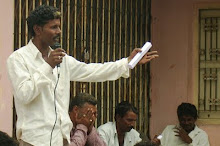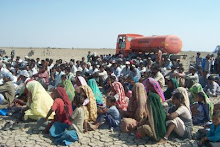Down to Earth: Delhi: Thursday 20 July 2023.
Issues pertaining to the settlement survey have not been addressed in the last 50 years, says memorandum
A group of saltpan workers
(locally called agariyas) made a representation to Gujarat Chief Minister
Bhupendrabhai Patel July 18, 2023 under the aegis of the Agariya Heet Rakshak
Manch (AHRM). They requested state intervention over forest department officials
issuing instructions barring their entry in the Little Rann of Kutch.
Members of Koli, Sandhi and Miyana communities residing in 100-125 villages surrounding the Little Rann of Kutch areas under North Gujarat, Kutch and Saurashtra regions are dependent on salt cultivation in the area. The saltpan workers from the districts of Patan, Kutch, Morbi and Surendranagar have been in the profession for 600-700 years, even since British rule.
In 1972, 4,953.70 square kilometres of the Little Rann of Kutch was declared a wild ass (Ghudkhar) sanctuary vide notifications issued under state laws, including Gujarat Wildlife and Birds Conservation Act, 1963.
After that, a settlement survey was undertaken in 1997, based on which saltpan workers were issued permits and land on lease to cultivate salt in the Little Rann of Kutch.
But the Gujarat government’s industries and mines department, which has missed on listing several traditional agariyas in the survey underaken in 2007. They are now demanding to get enrolled in the same settlement survey books.
In the latest memorandum to the chief minister, the representatives of the agrieved agariyas have attached documents of historic value dating back to the British era of the community members engaged in salt cultivation.
They have also incorporated memorandum from the multiple representations made by the left-out agariyas to concerned government offices to get themselves enlisted.
In context to the ongoing pleas in the Gujarat High Court as well as in the National Green Tribunal alleging land-poaching activities in the Little Rann of Kutch, for which the forest department needs to submit the report on the procedures done in the same matter, the department officials conducted area-wise meetings with agariyas.
Amid an ongoing legal battle altogether in different matters and even as the survey-settlement report is yet under the state government's consideration and scrutiny, forest department officials referring to same report, in the area-wise meetings issued instructions mentioning that those agariyas whose names are not listed vide the survey-settlement report will be denied entry into the Little Rann of Kutch area from next season.
Above orders from forest department officials have compelled them to make representation to the highest office in the state that is the Chief Minister's Office in Gujarat.
The issues pertaining to the settlement survey have not been addressed in the last 50 years, the representatives highlighted.
They also pointed out that the number of wild ass in the area rose to 6,082 in 2019 from 700 in 1973, according to census. If the man-animal conflict actually existed, which has been cited as a reason for the entry restriction, the wild ass population wouldn’t have seen this growth.
Several bodies representing saltpan workers also noted that saltpan workers use 6 per cent of the total land area for salt cultivation in Little Rann of Kutch, which is negligible in quantum and space.
There have been instances in the past, where saltpan workers were either denied entry or were asked to move out from the site, by the concerned agencies, which following some political pressure used to settle down.
Pankti Jog, volunteer with AHRM, explained the reason why the matter has resurfaced. She added:
There are almost 8,000 families who engage in salt cultivation activities in the Little Rann of Kutch. Now out of 100-125 villages, the forest department officials conducted meetings at 16 villages and 95 per cent of the names of agariyas were struck out. This raised concerns and so agariyas were left with no option but to represent their voice to the highest authority in the state.
While the survey-settlement report is yet under the state government scrutiny and consideration, how can the poor salt-pan workers be punished, in some other matters such as land-poaching, which have been piling up in the court since past few decades, Jog questions.
“This matter is under dispute since last 50 years, since the area has been declared as Wildlife Sanctuary in 1973,” added Jog. “So now, we are asking the highest authority in the state to intervene into the matter and let these people earn their traditional and ancestral livelihood, which they have been practicing since the last 6-7 centuries.”
Officials of the Gujarat forest department were not accessible or available to comment or provide details regarding the allegations made in the memorandum submitted by AHRM.
Saltpan workers residing in nearby villages surrounding Little Rann of Kutch camp for eight months after monsoon season in the area, where sources of salt and sweet waters deposit.
After the water evaporates, salt deposits are cultivated to get rock or slump salt (locally called gangda mithu), which is sold to the business fraternity engaged in the selling of this raw salt.
Usually agariyas take financial aid from the same business fraternity to camp and cultivate the salt from the area. Once the salt is harvested, it is sold to the same business fraternity from whom they have taken financial aid or loan.
Other concerns presented in the memorandum included the fact that most of the agariyas listed in the settlement survey report are not alive today.
The co-operative societies operated by agariyas have gone bankrupt and have no locus standi (legal standing), they stressed.
Few claims have been passed, which are stuck following the Gujarat High Court verdicts, for cases where the land lease has expired and not been renewed, the representatived pointed out. So, even the approved claims do not stand of any value, they added.
The state government has already issued Class-1 Identity Cards (known as agariyapothi) and have channelised several welfare schemes for agariyas and their families, including education, health, drinking water through the state-empowered committee for the salt industry.
In the memorandum submitted to the Gujarat Chief Minister’s Office, the agariyas have further requested that the state continues validating the “seasonal community user rights” and do the needful in the same direction.
Issues pertaining to the settlement survey have not been addressed in the last 50 years, says memorandum
 |
| Saltpan worker representatives claim that wildass population in the area wouldn't have grown if there was human-wildlife conflict. Photo: iStock |
Members of Koli, Sandhi and Miyana communities residing in 100-125 villages surrounding the Little Rann of Kutch areas under North Gujarat, Kutch and Saurashtra regions are dependent on salt cultivation in the area. The saltpan workers from the districts of Patan, Kutch, Morbi and Surendranagar have been in the profession for 600-700 years, even since British rule.
In 1972, 4,953.70 square kilometres of the Little Rann of Kutch was declared a wild ass (Ghudkhar) sanctuary vide notifications issued under state laws, including Gujarat Wildlife and Birds Conservation Act, 1963.
After that, a settlement survey was undertaken in 1997, based on which saltpan workers were issued permits and land on lease to cultivate salt in the Little Rann of Kutch.
But the Gujarat government’s industries and mines department, which has missed on listing several traditional agariyas in the survey underaken in 2007. They are now demanding to get enrolled in the same settlement survey books.
In the latest memorandum to the chief minister, the representatives of the agrieved agariyas have attached documents of historic value dating back to the British era of the community members engaged in salt cultivation.
They have also incorporated memorandum from the multiple representations made by the left-out agariyas to concerned government offices to get themselves enlisted.
In context to the ongoing pleas in the Gujarat High Court as well as in the National Green Tribunal alleging land-poaching activities in the Little Rann of Kutch, for which the forest department needs to submit the report on the procedures done in the same matter, the department officials conducted area-wise meetings with agariyas.
Amid an ongoing legal battle altogether in different matters and even as the survey-settlement report is yet under the state government's consideration and scrutiny, forest department officials referring to same report, in the area-wise meetings issued instructions mentioning that those agariyas whose names are not listed vide the survey-settlement report will be denied entry into the Little Rann of Kutch area from next season.
Above orders from forest department officials have compelled them to make representation to the highest office in the state that is the Chief Minister's Office in Gujarat.
The issues pertaining to the settlement survey have not been addressed in the last 50 years, the representatives highlighted.
They also pointed out that the number of wild ass in the area rose to 6,082 in 2019 from 700 in 1973, according to census. If the man-animal conflict actually existed, which has been cited as a reason for the entry restriction, the wild ass population wouldn’t have seen this growth.
Several bodies representing saltpan workers also noted that saltpan workers use 6 per cent of the total land area for salt cultivation in Little Rann of Kutch, which is negligible in quantum and space.
There have been instances in the past, where saltpan workers were either denied entry or were asked to move out from the site, by the concerned agencies, which following some political pressure used to settle down.
Pankti Jog, volunteer with AHRM, explained the reason why the matter has resurfaced. She added:
There are almost 8,000 families who engage in salt cultivation activities in the Little Rann of Kutch. Now out of 100-125 villages, the forest department officials conducted meetings at 16 villages and 95 per cent of the names of agariyas were struck out. This raised concerns and so agariyas were left with no option but to represent their voice to the highest authority in the state.
While the survey-settlement report is yet under the state government scrutiny and consideration, how can the poor salt-pan workers be punished, in some other matters such as land-poaching, which have been piling up in the court since past few decades, Jog questions.
“This matter is under dispute since last 50 years, since the area has been declared as Wildlife Sanctuary in 1973,” added Jog. “So now, we are asking the highest authority in the state to intervene into the matter and let these people earn their traditional and ancestral livelihood, which they have been practicing since the last 6-7 centuries.”
Officials of the Gujarat forest department were not accessible or available to comment or provide details regarding the allegations made in the memorandum submitted by AHRM.
Saltpan workers residing in nearby villages surrounding Little Rann of Kutch camp for eight months after monsoon season in the area, where sources of salt and sweet waters deposit.
After the water evaporates, salt deposits are cultivated to get rock or slump salt (locally called gangda mithu), which is sold to the business fraternity engaged in the selling of this raw salt.
Usually agariyas take financial aid from the same business fraternity to camp and cultivate the salt from the area. Once the salt is harvested, it is sold to the same business fraternity from whom they have taken financial aid or loan.
Other concerns presented in the memorandum included the fact that most of the agariyas listed in the settlement survey report are not alive today.
The co-operative societies operated by agariyas have gone bankrupt and have no locus standi (legal standing), they stressed.
Few claims have been passed, which are stuck following the Gujarat High Court verdicts, for cases where the land lease has expired and not been renewed, the representatived pointed out. So, even the approved claims do not stand of any value, they added.
The state government has already issued Class-1 Identity Cards (known as agariyapothi) and have channelised several welfare schemes for agariyas and their families, including education, health, drinking water through the state-empowered committee for the salt industry.
In the memorandum submitted to the Gujarat Chief Minister’s Office, the agariyas have further requested that the state continues validating the “seasonal community user rights” and do the needful in the same direction.
















.jpg)
.jpg)
.jpg)
.jpg)













No comments:
Post a Comment